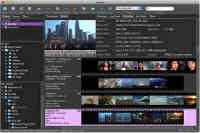 There were 2 good responses on a question on archiving digital video (mini DV) on the SF Cutters e-mail list today. Jim Feeley (editor at DV magazine in its heyday) suggested iDive, a simple semi-automatic cataloging program for Mac and CatDV (Mac/Win):
There were 2 good responses on a question on archiving digital video (mini DV) on the SF Cutters e-mail list today. Jim Feeley (editor at DV magazine in its heyday) suggested iDive, a simple semi-automatic cataloging program for Mac and CatDV (Mac/Win):"Feed the tapes into your VTR or camera, let iDive scan each tape and add sample images from each clip (or several images from longer clips) to its simple visual database. Oh, it also catalogs all the video, too. You don't need to sit down and hand log everything.
...
I don't use iDive for stuff I've carefully shot. And there are more robust asset management apps (such as CatDV) that I use. But iDive is pretty nice and might really help you catalog, archive, and discover what's on those tapes without going crazy."
Another option is Frameline 47 for Mac-- it's no longer in development but now available free with an NFR serial number. It EOLed in September 2010 so it may still work for many people.
Another person on Cutter-Talk sugested looking at videos by Chris Fenwick (embedded below) based on presentations at recent SF Cutters meetings; see Saving data can be cheap Part 1 and Part 2. Chris says:
"Remember, this is not the fastest method, this is not the most LONG LASTING system, and there are many people that will tell you I’m NUTS for storing data this way. However, I manage about 100TB of data this way and have used it for about 10 years. So, take that for what its worth. ...[Part 2 talks] about how to FIND everything you’ve stored."
4 comments:
Wonderful information and a pleasure to watch. My preferred method is based on using the OWC Mercury Elite 1 tb drive. Especially since sometimes the client want the footage after the edit. Being a tape guy (CMX, Apex VPRs, etc) it did my heart good to hear about your experience of reliability and longevity with disk based storage.
You might also visit the video author's website -- he has a bunch of other stuff too; see links above!
Yes, I visited the site when I watched the 2 tutorials. I like the idea of using the software to get a printed readout of the drives contents. But the hardware approach he uses is to restrictive if you work with clients that want the footage. The OWC drives are a good alternative and much easier for others to use.
Thanks for the info Tom.
Post a Comment